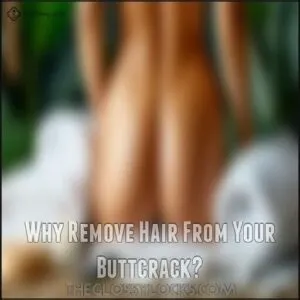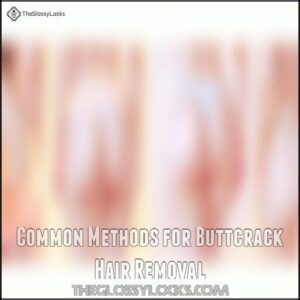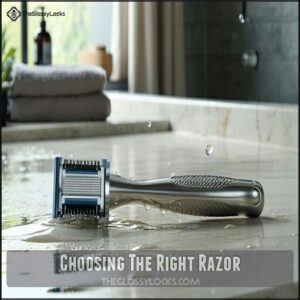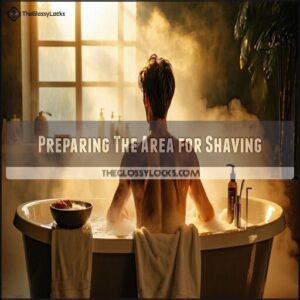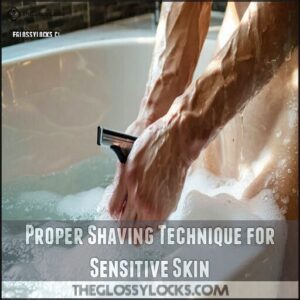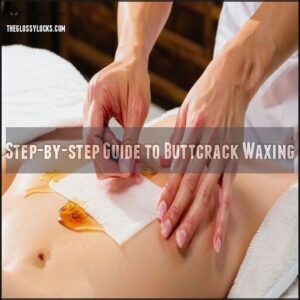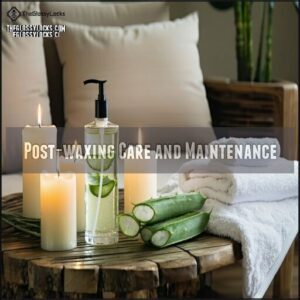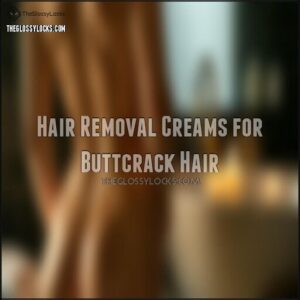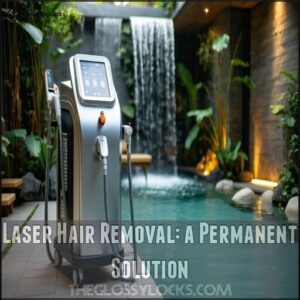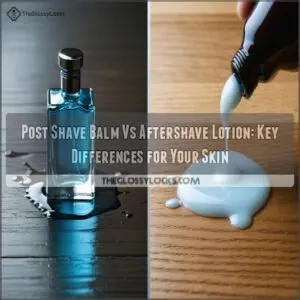This site is supported by our readers. We may earn a commission, at no cost to you, if you purchase through links.
 Tired of dealing with buttcrack hair? You’ve got multiple options to tackle this personal grooming challenge.
Tired of dealing with buttcrack hair? You’ve got multiple options to tackle this personal grooming challenge.
Shaving offers a quick at-home solution, but be careful—use a clean, sharp razor and go slow in sensitive areas.
Waxing provides longer-lasting results, though it can be painful. Depilatory creams work well for some, but always do a patch test first.
For a more permanent approach, consider laser hair removal—it’s pricier but can substantially reduce hair growth.
Remember to prep your skin, use gentle techniques, and moisturize afterward to prevent irritation. Each method has pros and cons, so choose what works best for your body and comfort level.
Table Of Contents
- Key Takeaways
- Why Remove Hair From Your Buttcrack?
- Common Methods for Buttcrack Hair Removal
- Shaving: a Quick and Easy Solution
- Waxing: Long-lasting Buttcrack Hair Removal
- Hair Removal Creams for Buttcrack Hair
- Laser Hair Removal: a Permanent Solution
- Natural Remedies for Buttcrack Hair Removal
- Preventing Irritation and Ingrown Hairs
- Frequently Asked Questions (FAQs)
- How to get rid of hair in your bum crack?
- How do you remove hair from your perineum?
- Is it normal to have hair in between your bum for a girl?
- Does bum hair go away?
- How to shave between buttocks?
- How to remove butt-crack hair?
- What are the ways to remove hair breakage?
- Does buttcrack hair disappear?
- How to remove body hair from buttocks?
- How do I get rid of ingrown hairs between my buttocks?
- Conclusion
Key Takeaways
- You’ve got multiple hair removal strategies tailored to your comfort and budget, including shaving, waxing, hair removal creams, and laser treatments, so you can choose what works best for your skin and pain tolerance.
- Always prioritize skin preparation and aftercare, using gentle techniques like warm showers, clean razors, and soothing moisturizers to minimize irritation and prevent ingrown hairs.
- Each hair removal method comes with unique pros and cons, so you’ll want to consider factors like pain level, cost, longevity of results, and your personal skin sensitivity before selecting a technique.
- Maintaining hygiene and personal comfort is the ultimate goal, so don’t be afraid to experiment with different methods and consult professionals if you experience any skin complications or persistent issues.
Why Remove Hair From Your Buttcrack?
You’ve likely wondered about hair in your buttcrack and whether removing it makes sense for personal comfort and hygiene.
Whether you’re concerned about sweat, seeking smoother skin, or wanting easier maintenance, understanding your hair removal options can help you make an informed decision about this sensitive area.
Hygiene Concerns and Sweat Reduction
While managing butt crack hair might seem awkward, understanding its impact on hygiene can transform your self-care routine.
Removing this hair offers significant benefits for skin health and comfort:
Liberate your skin! Buttcrack hair removal is your ticket to comfort, confidence, and zero sweat drama.
- Dramatically reduces sweat accumulation
- Minimizes bacterial growth
- Prevents odor-causing bacteria
- Decreases skin irritation risks
- Enhances overall butt crack hygiene
By strategically addressing hair in this sensitive area, you’ll dramatically improve moisture management and reduce friction.
Proper hair removal techniques create a cleaner, more comfortable environment, helping you feel confident and fresh throughout the day.
Comfort During Physical Activities
The comfort of your athletic pursuits hinges on unexpected details like butt crack hair management.
Friction reduction becomes essential during workouts, where unwanted hair can transform simple movements into uncomfortable experiences.
By removing butt hair, you’ll minimize skin chafing and prevent irritation that could compromise your athletic performance.
By removing butt hair, you’ll minimize skin chafing and prevent irritation that could compromise your athletic performance.
Smooth skin allows for better sweat management and reduces the risk of painful rubbing or potential sports-related skin injuries.
Strategically eliminating buttock hair creates a protective barrier against discomfort, enabling you to focus entirely on your fitness goals.
Implement careful hair removal techniques to enhance your physical comfort and maintain peak movement during exercise.
Personal Aesthetic Preferences
Since body image plays a pivotal role in self-perception, your butt hair removal journey is deeply personal.
Your aesthetic goals and personal style guide this intimate grooming choice.
Consider these motivations:
- Boost confidence through intentional body care
- Express individual grooming preferences
- Align with contemporary beauty standards of smooth, hair-free skin
Easier Cleaning and Maintenance
Your bathroom routine just got a game-changer with butt crack hair removal! Say goodbye to trapped sweat and hello to effortless cleaning.
Without hair blocking your path, hygiene becomes a breeze, making every wipe more effective and thorough. Gentle exfoliation prevents pesky ingrown hairs while keeping your skin smooth and healthy.
Those sensitive areas? They’ll thank you for the extra care. By implementing smart hair removal techniques, you’ll experience a fresh feeling that lasts all day.
Soft, clean skin is no longer a distant dream but your new reality. Embrace the freedom of simplified daily cleansing and step into a more confident, hair-free you.
Common Methods for Buttcrack Hair Removal
Got four key hair removal methods for your buttcrack that’ll change your game in 2025? Let’s get started:
- Waxing: Your smooth skin solution that lasts 2-4 weeks
- Shaving: Quick but requires precision
- Hair Removal Creams: Convenient chemical solution
- Permanent Treatments: Laser or electrolysis for long-term results
Picking the right butt crack hair removal method isn’t just about aesthetics—it’s about comfort and confidence. Your choice depends on pain tolerance, budget, and skin sensitivity.
Professionals recommend testing methods carefully to avoid irritation. While temporary solutions like shaving offer immediate results, more permanent treatments provide lasting smoothness.
Remember, everyone’s body is different, so what works for your buddy mightn’t work for you. Prioritize your comfort and skin health above all else.
Understanding hair removal techniques is vital for making an informed decision about your hair removal method.
Shaving: a Quick and Easy Solution
If you’re looking to remove hair from your buttcrack, shaving offers a quick and straightforward solution that you can easily do at home.
By following the right techniques and using appropriate tools, you’ll minimize irritation and achieve smoother results with minimal discomfort.
Choosing The Right Razor
When picking a razor for your buttcrack, zero in on precision tools designed for sensitive areas.
Stainless steel blades with ergonomic, non-slip handles offer the best defense against razor bumps and irritation.
Look for razors with multiple safety features like pivoting heads and moisture strips.
Your ideal razor should glide smoothly, providing control and comfort while minimizing the risk of nicks.
Choose wisely to transform your shaving experience from dreaded to dependable. Considering the benefits of a stainless steel razor can help you make an informed decision.
Preparing The Area for Shaving
Every painstakingly planned butt crack grooming session demands strategic skin preparation.
Your pre-shave ritual can make or break the hair removal experience. Here’s your game plan:
- Warm Shower Power: 10 minutes softens hair and opens pores
- Exfoliation Station: Gentle circular motions with a soft washcloth
- Hygiene Harmony: Clean with mild, unscented soap and pat dry
Position yourself comfortably with good lighting, apply a protective pre-shave oil, and transform an awkward task into a smooth, confidence-boosting grooming moment.
Precision and care are your secret weapons.
Proper Shaving Technique for Sensitive Skin
Ready to master buttcrack hair removal without the ouches? Your secret weapon is precision and gentleness. Sharp razors are your first defense against irritation—think of them like a surgeon’s scalpel, precise and clean.
| Step | Technique | Pro Tip |
|---|---|---|
| Prep | Sharp Razor | Replace blades frequently |
| Cream | Sensitive Skin Gel | Use hypoallergenic products |
| Motion | Short Strokes | Follow hair growth direction |
| Pressure | Light Touch | Minimal contact prevents burns |
When shaving sensitive regions, think smooth jazz, not heavy metal. Glide with minimal pressure, using a fresh razor and sensitive skin shaving cream. Short, careful strokes following hair growth minimize razor bumps and keep your skin happy and bump-free.
Aftercare to Prevent Irritation
After smoothing away unwanted hair, your post-shave routine matters more than you might think.
Skin soothing becomes your top priority to prevent irritation and keep things comfortable.
- Pat the area dry with a clean, soft towel and apply a fragrance-free moisturizer that calms sensitive skin.
- Gently exfoliate every other day to ward off those pesky ingrown hairs.
- Choose breathable cotton underwear that lets your skin breathe and heal.
If razor bumps or mild folliculitis pop up, cool compresses and antibiotic cream can be your quick fix.
Stay loose, stay cool, and let your skin recover.
Waxing: Long-lasting Buttcrack Hair Removal
If you’re tired of constantly dealing with buttcrack hair and want a longer-lasting solution, waxing might be your best bet.
It’ll remove hair from the root, giving you smoother skin for weeks and helping you feel more confident in your personal hygiene routine, with a solution that provides a longer-lasting effect by removing hair from the root.
Professional Vs. At-home Waxing
The waxing battlefield presents two strategic options for butt crack hair removal: professional expertise versus do-it-yourself determination.
The waxing battlefield is complex, with each option offering unique benefits and drawbacks.
Professional waxing delivers precision and reduced pain, with trained specialists traversing sensitive terrains using high-quality products.
You’ll invest more money, but gain peace of mind through expert techniques customized to your skin’s unique landscape.
At-home waxing slashes costs and offers scheduling flexibility, but demands courage and skill.
The DIY route comes with increased risks of uneven hair removal, potential skin irritation, and learning curve bumps.
Types of Wax Suitable for Sensitive Areas
Mastering butt crack hair removal requires choosing the right wax for your sensitive skin. Hard wax emerges as the champion for intimate areas, offering a gentle yet effective solution.
Here’s your wax wisdom:
- Hard Wax: Your go-to for minimal irritation and precision hair removal
- Sugar Wax: A natural, hypoallergenic option that’s kind to sensitive skin
- Warm Wax: Perfect for gripping those stubborn, coarse hairs without causing a painful scene
Pro tip: Always select a wax designed specifically for delicate areas to keep your skin happy and hair-free. Understanding hard wax products is vital for effective hair removal in sensitive areas.
Step-by-step Guide to Buttcrack Waxing
Every hair removal journey demands precision, especially when tackling sensitive areas like the buttcrack.
Master buttcrack waxing by first ensuring perfect wax temperature and a squeaky-clean surface.
Apply thin wax layers strategically, following natural hair growth direction.
Press wax strips firmly, stretching skin taut for minimal discomfort.
Pull strips swiftly against hair growth, working methodically in small, manageable sections.
Pro tip: consistency and technique matter more than speed when executing this delicate hair removal technique.
Post-waxing Care and Maintenance
You’ve bravely conquered the wax, now it’s time to pamper your skin! Post-waxing care is essential for maintaining that silky-smooth feeling and preventing irritation.
- Apply cooling aloe vera gel to soothe inflammation and reduce redness
- Opt for loose, breathable clothing to prevent friction and allow skin recovery
- Pause intense workouts for 24-48 hours to minimize sweat-related complications
- Begin gentle exfoliation after 48 hours to ward off potential ingrown hairs
Your skin’s comfort is the ultimate victory!
Hair Removal Creams for Buttcrack Hair
If you’re looking for a quick, painless way to remove buttcrack hair, hair removal creams might be your go-to solution.
These chemical-based products dissolve hair at the surface, offering a smooth result without the nicks and cuts of traditional shaving.
Selecting The Right Depilatory Cream
Ready to smooth out your hair removal strategy?
Picking the right depilatory cream for your buttcrack requires smart selection.
Look for specialized intimate area formulas packed with skin-soothing ingredients like aloe vera and chamomile.
Your hair texture plays a big role – thicker hair demands stronger cream types, while fine hair works best with gentler options.
Consider cream application methods carefully; some brands offer precision spatulas for tricky areas.
Pro tip: read labels and opt for products designed specifically for sensitive skin.
Online shopping makes finding these creams a breeze, giving you multiple options to achieve that hair-free butt with minimal fuss and maximum comfort.
When choosing a depilatory cream, understanding depilatory cream benefits is essential for effective hair removal.
Patch Testing for Skin Sensitivity
When choosing a hair removal cream for sensitive areas, your skin’s reaction matters most.
Patch testing is your first line of defense against potential allergic responses. Apply a small amount of cream to your inner forearm and wait 24 hours.
Watch for redness, itching, burning, or rash—these are warning signs of skin sensitivity. If any irritation appears, steer clear of the product.
This simple test can save you from painful ingrown hairs, razor bumps, and uncomfortable folliculitis. Understanding sensitive skin needs is essential for selecting the right hair removal products.
Application and Removal Process
When tackling buttcrack hair removal, depilatory creams offer a quick solution with the right technique. Your game plan for safe and effective application involves precision and care.
- Apply a thick, even layer using the provided spatula
- Keep the cream on for the exact time specified
- Remove gently with downward strokes using a damp washcloth
- Rinse thoroughly with lukewarm water
Ensure your skin is completely dry before starting, working methodically in sections. Stand in good lighting to guarantee complete coverage and prevent missed spots.
Move carefully, avoiding excessive pressure or rubbing. Think of this as a delicate dance – gentle, controlled movements are key to a smooth, hair-free experience without irritation.
Potential Risks and Side Effects
Hair removal creams might seem like a quick fix, but they pack potential pitfalls for your sensitive posterior region.
Skin Irritation and Razor Burns can turn your smooth dreams into an itchy nightmare. Allergic Reactions might spark unexpected discomfort, while infections lurk in warm, moist environments. Ingrown hairs can transform your quest for silky skin into a painful ordeal.
Before slathering on that cream, consider your skin’s unique sensitivity and always—always—do a patch test first. Your buttcrack deserves careful consideration, not a chemical assault.
Risk Precaution Why It Helps
Skin Irritation Patch test first Identifies potential allergic reactions
Allergic Reactions Use hypoallergenic creams Minimizes adverse skin responses
Bacterial Infections Keep area clean and dry Prevents microorganism growth
Ingrown Hairs Exfoliate gently Reduces hair re-entry into skin
Laser Hair Removal: a Permanent Solution
If you’re tired of constantly battling butt crack hair, laser hair removal might be your ultimate solution.
This cutting-edge treatment offers a permanent way to reduce unwanted hair growth, giving you smoother skin with just a few professional sessions.
How Laser Treatment Works on Buttcrack Hair
In one swift zap, laser hair removal targets the melanin in your hair follicles with FDA-approved precision.
This innovative skin liberation technique transforms unwanted butt crack hair into a distant memory.
- Laser Safety: Minimally invasive targeting protects surrounding skin
- Treatment Costs: Long-term investment reduces future hair removal expenses
- Removal Efficacy: Customized approach based on individual hair characteristics
The process feels like a quick rubber band snap—uncomfortable yet manageable, promising smoother, hair-free results that’ll make you feel confident and clean.
Number of Sessions Required for Effectiveness
You’ll zap away buttcrack hair with 6-8 laser sessions, strategically spaced 8 weeks apart.
Each treatment targets different hair growth cycles, gradually reducing unwanted fuzz.
Most folks notice significant hair reduction after 4 sessions, though results depend on your unique hair thickness and color.
Your journey to smooth skin requires patience and precision.
Cost Considerations and Long-term Benefits
Slashing unwanted buttcrack hair isn’t just about aesthetics—it’s a smart financial strategy.
Laser hair removal delivers long-term savings that’ll make your wallet smile.
Consider these wallet-friendly advantages:
- Eliminate ongoing expenses for razors, waxing, and creams
- Reduce time-consuming hair maintenance routines
- Invest in permanent hair reduction technology
With national average session costs ranging from $207-$913, strategic budget planning transforms this procedure from an expense to a savvy investment in personal comfort and confidence.
By opting for laser hair removal treatments, individuals can achieve significant reductions in unwanted hair.
Potential Side Effects and Contraindications
After investing in laser sessions, you might encounter unexpected skin drama.
Potential roadblocks include temporary redness, itching, and allergic reactions that can turn your smooth dream sideways.
Not everyone’s a perfect candidate—pregnancy, certain medications, and specific skin types could disqualify you.
Understanding the benefits of low level laser therapy can help mitigate these risks.
Always consult a certified professional to navigate these potential pitfalls safely, considering laser hair growth effects.
| Risk | Likelihood | Management |
|---|---|---|
| Skin Irritation | Moderate | Cool compress |
| Infections | Low | Proper aftercare |
| Ingrown Hairs | High | Exfoliation |
Natural Remedies for Buttcrack Hair Removal
If you’re looking for gentler alternatives to traditional hair removal methods, natural remedies can offer a more skin-friendly approach to managing buttcrack hair.
From sugar waxing to herbal treatments and strategic lifestyle changes, you’ll discover multiple techniques that can help reduce hair growth while minimizing irritation and discomfort, using natural remedies.
Sugar Waxing (sugaring) Technique
The gentle art of sugaring transforms butt crack hair removal into a natural, less painful experience. This ancient technique crafts a sweet solution using sugar, lemon juice, and water to pull hair from the root effortlessly.
- Minimally invasive hair removal method
- Adheres only to hair, sparing skin
- Natural ingredients reduce irritation risks
- Results last 2-4 weeks consistently
- Warm water cleanup makes process simple
With practice, you’ll master this skin-friendly alternative to traditional waxing, leaving you feeling smooth and confident. The use of natural ingredients is a key factor in this method.
Herbal Hair Growth Inhibitors
Discover the power of herbal hair growth inhibitors to naturally manage unwanted buttcrack hair.
These botanical treatments work quietly behind the scenes, slowing hair regrowth with plant-based magic.
| Product Type | Benefits | Cost Range | Sensitivity |
|---|---|---|---|
| Sprays | Quick application | $10-$30 | Low irritation |
| Creams | Deep follicle targeting | $15-$50 | Gentle formula |
| Oils | Moisturizing effect | $12-$40 | Skin-friendly |
| Serums | Concentrated treatment | $20-$60 | Precise application |
Natural inhibitors like StopHair and NEUD leverage plant extracts to deactivate hair bulb activities.
Derived from ingredients such as Curcuma aeruginosa and spearmint, these solutions offer a gentler alternative to harsh chemical treatments.
Consistency is key – apply after hair removal for best results, and always patch test to confirm skin compatibility.
Your journey to smoother skin starts with these innovative herbal remedies.
Exfoliation Methods to Reduce Hair Growth
Master your butt crack hair removal game with strategic exfoliation techniques that keep your skin smooth and clear.
Here’s your game plan for effective hair management:
- Scrub away dead skin with sugar or salt exfoliants
- Use chemical peels targeting ingrown hair prevention
- Apply microdermabrasion twice weekly with a soft brush
- Moisturize post-treatment with alcohol-free products
These methods break down barriers to smooth skin, clearing follicles and making future hair removal a breeze. By consistently removing dead skin cells, you’ll reduce hair growth and achieve that clean, refreshed feeling you’re after, with the ultimate goal of mastering hair removal techniques.
Diet and Lifestyle Changes for Hair Management
After smoothing away unwanted hair, your diet becomes another powerful weapon in managing body hair growth.
Your hormone balance directly influences those pesky strands, especially with conditions like PCOS or hirsutism.
- Load up on omega-3 rich foods, zinc, and selenium to regulate hair patterns
- Keep hormones in check with vitamin D and anti-inflammatory nutrition
- Consider B-complex and iron supplements (with your doc’s thumbs-up)
Remember: while nutrition plays a role, your genes still call the shots on hair growth.
Preventing Irritation and Ingrown Hairs
When tackling buttcrack hair removal, you’ll want to take steps to minimize skin irritation and prevent those pesky ingrown hairs that can cause discomfort.
By following proper techniques and using the right products, you’ll keep your skin smooth, healthy, and free from the annoying bumps and redness that often accompany hair removal, which helps to prevent ingrown hairs.
Proper Cleansing and Exfoliation Techniques
After exploring natural hair removal techniques, your skin needs strategic care.
Skin preparation is an art form when targeting sensitive areas like the butt crack.
Start your daily cleansing routine with warm water to open pores and remove dead skin cells.
Use soft washcloths and pH-balanced soap to prevent irritation during butt crack hair removal.
Gentle exfoliants are your secret weapon against ingrown hairs, keeping the skin smooth and refreshed without harsh scrubbing.
To minimize irritation and ingrown hairs, understanding shaving preparation techniques is essential for effective hair removal.
Moisturizing and Soothing The Skin
After hair removal, your delicate skin craves tender loving care.
Soothe those sensitive areas with strategic skin protection techniques that’ll keep you comfortable and bump-free.
- Dab cooling aloe vera gel to calm irritated skin instantly
- Apply hypoallergenic moisturizer to rebuild your skin’s protective barrier
- Massage healing coconut oil before bed to nurture and protect
Your butt crack deserves compassionate aftercare that prevents irritation and promotes smooth, healthy skin.
This will help you achieve smooth, healthy skin and prevent any discomfort.
Wearing Breathable, Loose-fitting Underwear
After soothing your skin, your underwear choice becomes a powerful ally in preventing post-hair removal discomfort.
Select breathable materials that keep you cool and comfortable.
| Material | Comfort Level | Breathability |
|---|---|---|
| Cotton | High | Excellent |
| Bamboo | Very High | Superior |
| Synthetic | Low | Poor |
| Silk | Medium | Good |
Loose-fitting designs prevent chafing and reduce the risk of ingrown hairs.
Ditch tight, restrictive underwear that traps moisture and irritates sensitive skin after butt crack hair removal.
When to Seek Medical Advice for Complications
How can you tell when a seemingly minor hair removal mishap requires professional intervention? Watch for these telltale infection signs after grooming:
- Angry, persistent bumps in your intimate areas
- Spreading redness that feels warm to touch
- Unexplained fever spiking above 101°F
- Stubborn sores refusing to heal within days
- Sudden, unusual hair growth patterns
Don’t downplay potential complications. While most razor burns and ingrown hairs resolve independently, certain symptoms demand medical attention.
Folliculitis, skin irritation, and recurring infections could signal underlying health issues. Consulting a healthcare professional early prevents minor problems from escalating into serious complications. Your body’s signals are vital – listen carefully and seek expert advice when something feels off.
Frequently Asked Questions (FAQs)
How to get rid of hair in your bum crack?
When nature’s carpet overstays its welcome, grab a trimmer or razor.
Carefully spread cheeks, use gentle strokes, and trim or shave with precision.
Moisturize afterward to soothe skin and prevent irritation.
Always prioritize comfort and cleanliness.
How do you remove hair from your perineum?
You’ll want to carefully trim or use specialized waxing techniques designed for sensitive areas.
Consider consulting a professional esthetician who can guide you through safe and hygienic hair removal methods suited to your needs.
Is it normal to have hair in between your bum for a girl?
Between nature’s design and personal preference, body hair varies widely.
You’re totally normal if you have hair between your bum cheeks.
It’s natural, protective, and nothing to be self-conscious about – every body is different.
Does bum hair go away?
Bum hair doesn’t naturally disappear.
It’s a normal part of your body’s growth pattern.
While some people experience lighter or less noticeable hair over time, most individuals will continue to have hair in this area throughout adulthood, which is a natural part of being an adult.
How to shave between buttocks?
Carefully spread cheeks and use a clean, sharp razor with shaving cream.
Trim hair first, shave in the direction of growth, rinse frequently, and apply moisturizer afterward to prevent irritation and maintain skin health.
How to remove butt-crack hair?
You might feel awkward, but butt-crack hair removal is totally normal.
Try trimming with a body groomer, waxing at a salon, or using an electric razor with a guard for a clean, smooth result that boosts your confidence.
What are the ways to remove hair breakage?
Choose the right method for your hair breakage: trim split ends, use deep conditioning treatments.
Apply leave-in conditioners, protect hair from heat damage, and opt for gentle hair accessories that minimize stress on fragile strands.
Does buttcrack hair disappear?
Peeking beneath the surface, buttcrack hair doesn’t magically vanish.
It’s a persistent companion that requires consistent removal techniques like shaving, waxing, or laser treatments to temporarily reduce or permanently minimize its presence.
How to remove body hair from buttocks?
You’ve got options for removing buttocks hair: shaving with a body groomer, waxing at home or professionally, using hair removal creams, or exploring laser treatments.
Choose the method that suits your comfort, budget, and skin sensitivity.
How do I get rid of ingrown hairs between my buttocks?
Between irritation and relief, ingrown hairs demand strategic care.
Gently exfoliate with a soft cloth, apply warm compresses, and use salicylic acid or tea tree oil to reduce inflammation and prevent infection in sensitive areas.
Conclusion
Perfectly Practical Personal Pruning: managing how to get rid of hair in buttcrack involves understanding your body’s unique needs.
You’ve learned multiple methods—from quick shaving to lasting laser treatments—each with distinct advantages.
Remember that personal grooming is about comfort, hygiene, and confidence.
Whatever technique you choose, prioritize skin health, use gentle methods, and don’t hesitate to consult professionals if you experience complications.
Your body, your choice—embrace what makes you feel clean and comfortable.
- https://www.ncbi.nlm.nih.gov/pmc/articles/PMC3988237/
- https://medicine.yale.edu/profile/mona-gohara/
- https://nuageaesthetics.com/blog/is-laser-hair-removal-worth-it-a-cost-and-benefits-analysis
- https://glowupmedspa.com/blogs/news/how-much-is-laser-hair-removal-a-complete-guide-to-cost-benefits-and-comparative-value
- https://www.webmd.com/beauty/laser-hair-removal

